When it comes to painting a surface, the first goal is making the paint stay longer and resistant to environmental conditions. It can be achieved by sealing your painted surface. At least I never forget to seal the paint, and it’s the uttermost step of my artwork.
If you’re painting on a plastic surface, the paint may not adhere to the surface as firmly as expected. So how to seal the acrylic paint on plastic and make it adhere to the surface strongly? I’ve discussed the procedure in detail.
Moreover, an accurate application of acrylic to plastic is described too. In addition, the alternatives to acrylic paint sealer are highlighted as well. Read the post thoroughly for detailed information.
How To Seal Acrylic Paint On Plastic?
Acrylic paint can be sealed on plastic material (cups, plates, toys, household items) using a regular acrylic sealer. It provides protection against physical damage and harsh environmental conditions. Moreover, varnish, mod podge, resins, and even some lubricants can be used as sealers.
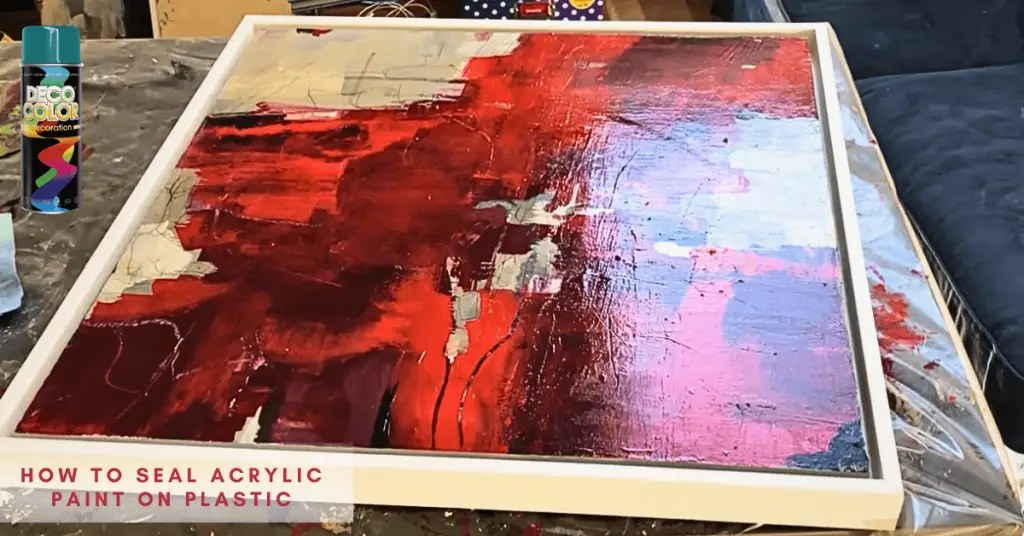
Why Is Sealing Acrylic Paint Necessary?
Why do we need to seal acrylic paint? There are multiple reasons. But most likely, sealing the painting is the final step, and without it, your artwork is incomplete. Below are some benefits of sealing paint on a surface.
- Sealing the paint gives protection against light, especially UV rays. Or otherwise, the strong rays will damage the paint’s consistency, and it will fade and get yellow over time.
- It also provides resistance against moisture. If your painting is going to stay outdoors, rain may damage the color. So there’s a need to protect it against water and moisture.
- Sealing the paint over the surface makes it more durable, which helps the painting survive minor physical damages, line scratches, rubs, oils, and spills.
- Moreover, sealing gives a final touch and durable finish to your artwork. In addition, a glossy, smooth, and even surface is achieved by applying sealant.
2 Types of Sealants
Sealants come in two primary forms or types depending on the convenience of use.
- Aerosol sealants are spray-like paints and can be very simple to handle and apply over surfaces. They are time-conserving as they don’t need to be prepared and applied with brushes.
- Regular Sealant is semi-fluid, comes in tubes or containers, and can be applied using routine painting procedures like applying with a brush.
How To Seal Acrylic Paint On Plastic Using Spray Sealer? Complete Procedure
Although spray sealer is quite simple to be used and apply without proper guidance, you may ruin your paint job or hurt your eyes, nose, lungs, and skin. Below is the step-by-step procedure for sealing the paint over the plastic top using spray or aerosol sealer.
Supplies Needed:
- Spray sealer
- Plastic material
- Mask
- Gloves
- Goggles
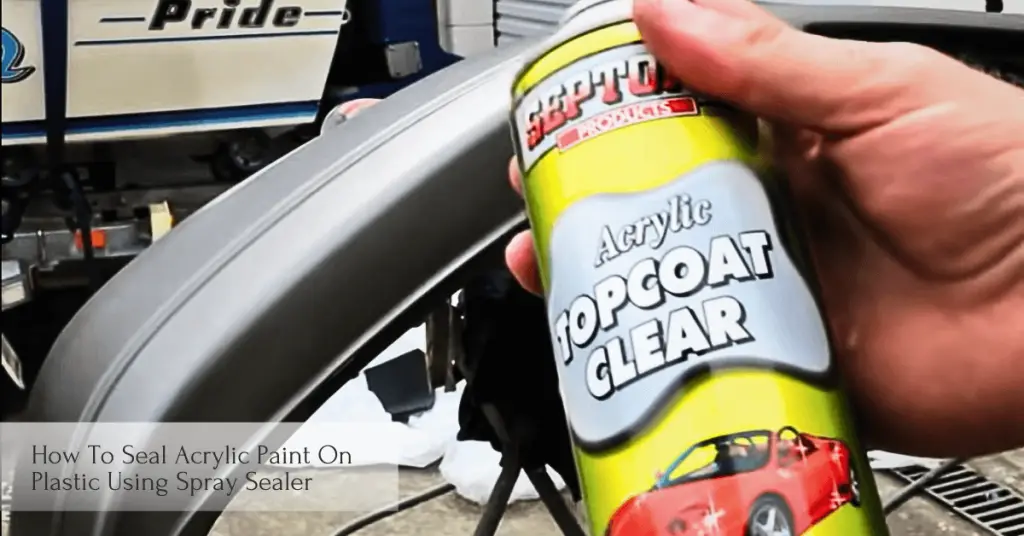
Step 1: Use Personal Protective Equipment
The first thing you need to focus on while using an aerosol sealer is protecting yourself. Wear a mask to protect your lungs and get the droplets inside the nose and mouth. Use goggles to protect your eyes and gloves so that your hands are safe from stains.
Step 2: Clean the painted surface
The next step is cleaning the painted plastic surface to reduce the dust particles and debris. These contaminants can reduce adhesion, durability, and smoothness. Although their effect is not apparent, they interfere with the sealer at the microscopic level.
Step 3: Shake the spray bottle well
Shake the spray bottle well before pressing the piston to apply the sealant. Shaking the bottle helps mix the sealant molecules, and uniform consistency is achieved. Moreover, it creates gas pressure inside the bottle, which is helpful in releasing the sealer.
Step 4: Apply the sealer
Hold the bottle a few inches away from the surface of the plastic. Press the piston and move the plastic vertically and horizontally in front of the coming drops of sealant. Apply the sealer thoroughly, and don’t miss a single spot. I advised my juniors to apply 2-3 layers of the sealant.
Step 5: Let it Dry
The final step is putting the plastic material under a fan or near a window to make it dry fast. It may take up to 20-30 minutes for the surface to get dry entirely. Don’t proceed with a wet surface.
Note: I suggest working near a window or ventilated location so that fumes of the sealant are not accumulated, which are dangerous for humans and animals.
How To Seal Acrylic Paint On Plastic Using Regular Acrylic Sealer?
Applying regular acrylic sealer over a plastic surface is different from spray sealant. It is a bit difficult and demands concentration. But it’s not a big deal if you know how to do it. Fortunately, you’re at the right place; I’ll guide you through the process, taking into account every possible step.
Supplies needed:
- Acrylic sealer
- Bowl
- Water
- Newspaper
- Piece of cloth
- Plastic surface
- Brush
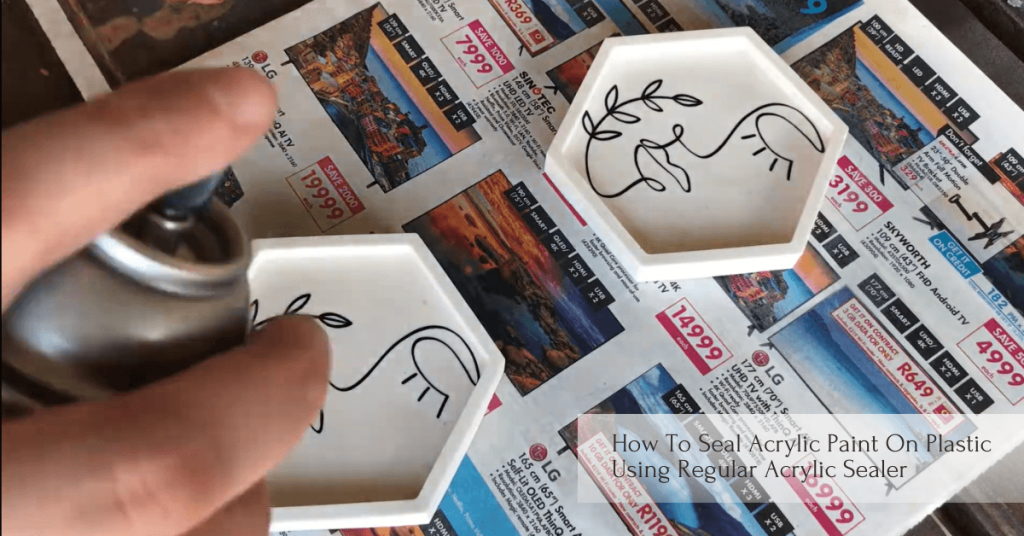
Step 1: Prepare the surface
You need to prepare the surface you’re going to apply sealer on. Preparation includes cleaning the surface using a clean piece of cloth. It will clear out all the dirt particles.
Step 2: Prepare the Sealer
The next step is preparing the sealer. It’s simple, just pour some sealer into the bowl and mix well. Add a medium to thin out the sealant if required. But I don’t suggest you thin down the sealer, as it will reduce its ability to protect the paint.
Step 3: Apply Vertical Layers
Now dip the brush into the bowl full of sealer and tap off the excess sealant. Apply over the plastic surface gently using vertical strokes. Make sure you’re applying the chemical evenly and covering every spot.
Step 4: Apply Horizontal Layers
Now repeat the process, but this time move the brush horizontally so that the probability of missing spots is minimised and the sealer is equally distributed over the surface.
Step 5: Add a Final Layer
I mostly use thin but multiple layers. So I would suggest you to apply an additional layer of sealer to ensure the paint is protected and sealed thoroughly.
Step 6: Let the Surface Dry
Once you’re done with sealing the paint on a plastic surface, let it dry. Put the material under a fan or near a windy location to speed up drying.
Step 7: Proceed with the sealed surface
You’re done with sealing the paint. You can proceed with the surface. The surface is now protected against a wide range of wear and tear.
Note: Don’t forget to tape the sections of plastic you don’t want to paint. After painting and sealing, remove the tape carefully and avoid spoiling your art.
Alternatives of Acrylic Sealer At Home
What if you’re out of sealer or it runs out during an art job? Will you leave the painted surface unsealed? Exactly not. You’ll try to find out an alternate way to fill out the gap. So let me tell you there are some alternatives to the sealer that are readily available and part of your household items.
These are inexpensive and good ways to seal acrylic paint over plastic and other surfaces.
- Nail Polish is an excellent alternative to paint sealer, but let me tell you, it gonna cost you more than regular acrylic paint sealer. At least my woman doesn’t allow me to use her costly nail polish as a sealant. So I suggest you choose this option only if you’re ready to open your wallet. Moreover, use clear nail polish for this purpose.
- WD-40 lubricant can be used for sealing acrylic paint over surfaces. It is primarily an anti-rust product but can be used to protect the painted surface from moisture, oils, and minor damage. Again, please don’t rely on this product, as it is a temporary source of sealing the paint.
- Vaseline is an everyday household skin moisturiser. If nothing from the above-mentioned products is available to protect your painted surface, vaseline can be used as an alternative. It protects against light, UV, oils, and minor wear and tear.
- Elmer’s Glue is another good option to be used over painted surfaces. The product is usually used for bonding purposes and is non-toxic. But with proper procedure, it can give a protective coat to your art.
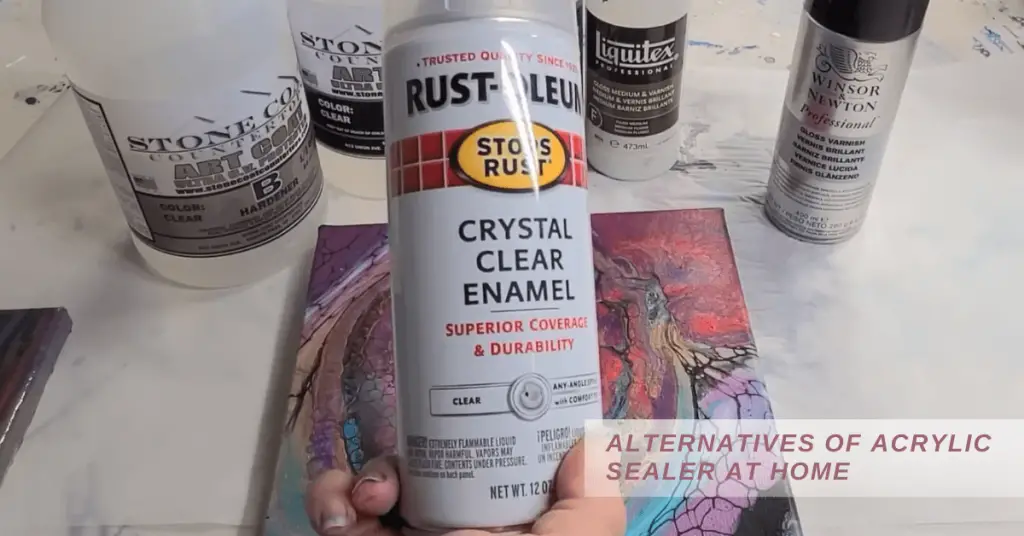
How to Use Varnish As Acrylic Sealer On Plastic?
A varnish is an excellent option for sealing acrylic paint over a plastic surface. But it should always be a second priority. The first should always be acrylic sealer, designed explicitly for water-based paints.
Varnish is usually used over furniture to give long-lasting wood protection and a glossy look. But sealing acrylic paint over plastic can also be done with this product. Again it’s not an ideal choice and can alter your paint’s tone. Below is the procedure for applying varnish over the acrylic painting.
Step 1: First of all, pour the varnish into a bowl and stir it well with a stirrer, stick, or a hard tool.
Step 2: Take a fine-haired brush and dip it into the bowl. Tap off the excess amount.
Step 3: Start applying the product by moving the brush gently over the surface. Make sure you’re using even and uniform strokes.
Step 4: Apply additional layers if needed. Let the previous layers dry first before moving on to the next ones.
Step 5: Finally, let the varnish dry well before proceeding with your art. It may take up to 1-3 hours for the varnish to dry completely.

How To Seal Acrylic Paint on Plastic Phone Cases?
Are you fond of painting your phone cases and giving them new designs? If so, you must be facing chipping off the paint over time. If you’re not aware, let me tell you it happens mostly because of not sealing the paint.
It is not that straightforward to paint a surface; let it dry, and you’re done. It would help if you sealed the paint to protect it from harsh conditions. Here is how you can seal plastic phone cases.
First of all, clean the surface thoroughly. Next, select a good-quality acrylic sealer or polyurethane varnish. Apply it over the painted surface uniformly and gently.
Make sure you apply the sealer using a fine-haired brush and use a thin coating. If you’re going for spray sealer, apply it in multiple layers. Finally, let the sealer dry nicely.
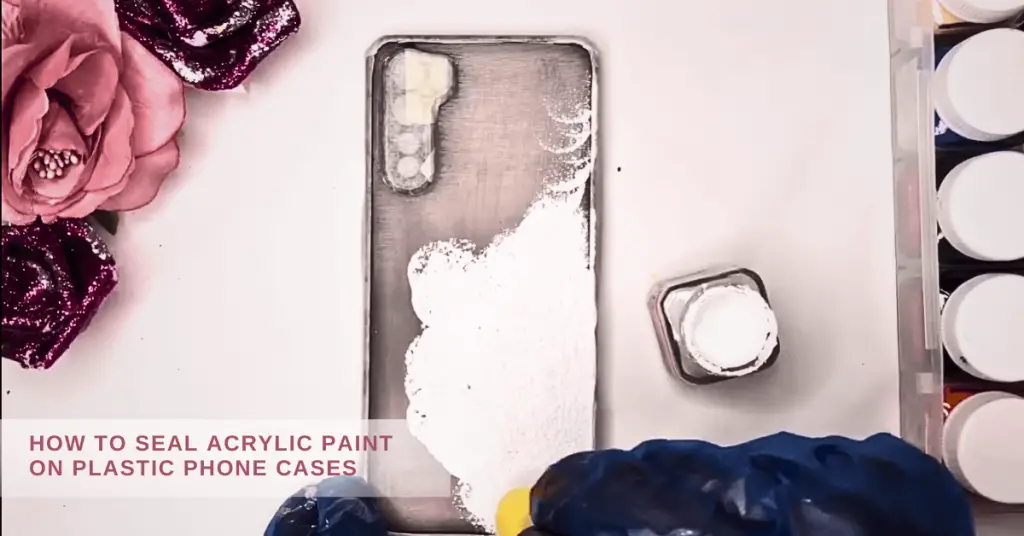
How to Seal Acrylic Paint on Plastic Cups?
Acrylic painting is fun and exciting, but getting them peeled off from the painted surfaces is frustrating, especially if you’re choosing a plastic surface like cups, plates, or toys.
Choosing a suitable sealer is a crucial step. My priority is a regular acrylic sealer that is transparent and highly resistant to moisture, UV rays, light, chemicals, and detergents. Simply pour the sealer into a bowl and mix it with a stirrer. Next, with the help of a brush, apply it over the surface evenly and smoothly.
Another good option is Mod Podge. It is a multipurpose product for painters which can be used as a primer and sealer. Apply it over the surface using the same application method discussed above.
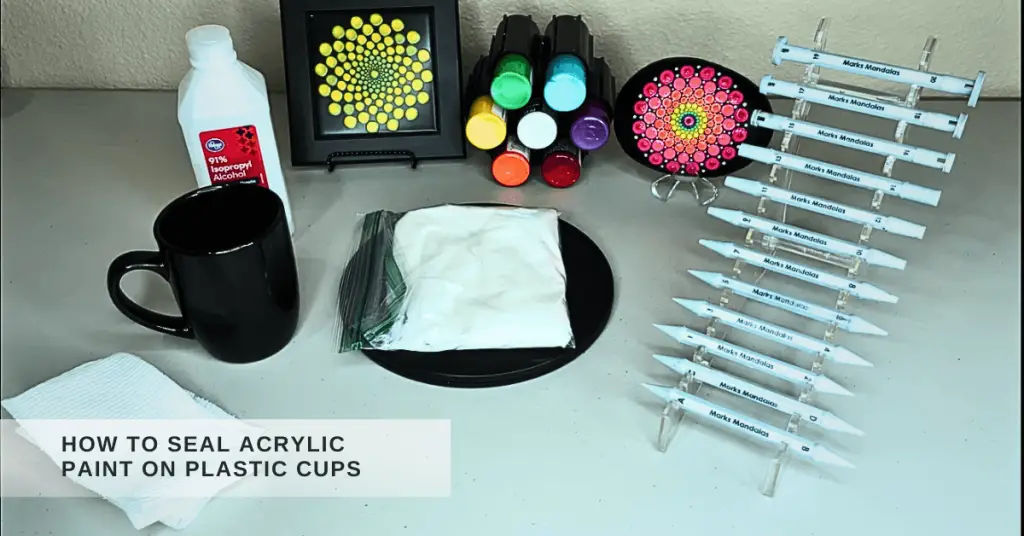
Best Acrylic Sealer For Plastic
You may find a variety of sealants to be applied over acrylic-painted plastic, but what suits your art the most is challenging to decide. Many manufacturers claim their product is long-lasting and durable. But mostly use low-grade resins and solvents, which can affect your painting. So decide wisely while buying a specific product.
I have mentioned some of the best acrylic sealers below, which are worth buying.
1. Krylon Acrylic Spray Paint
This product is mainly used for larger paintings, making it a widely used sealer for paint jobs, art schools, and museum paintings. It protects against many harsh conditions, including moisture, UV rays, and heat. Moreover, it gives a shiny look to your final painting.
It is a fast-drying sealer, easy to apply over the surface, and has good coverage. I recommend you apply thin layers of the product evenly with a fine-haired brush.
2. Rust-Oleum Universal All Surface Clear Topcoat
I prefer this product as it can be applied over almost every surface, including plastic, glass, wood, rocks, fabrics, etc. It dries very quickly, making it my first priority.
It leaves a hard layer over the surface, which improves adhesion. Long-lasting resistance is provided against weathering and physical damage. In addition, a glossy look is provided by the sealer.
You can also read: Can you use acrylic paint on silicone?
FAQs
Can You Use Hairspray To Seal Acrylic Paint On Plastic?
Yes, hair spray is a good alternative to acrylic sealer, but it’s not a permanent solution. It provides a tough layer that is resistant to minor scrapes and weathering. Be careful while using it, as thick layers can fade the colour of your painting.
Can you use acrylic paint on styrofoam plastic?
Yes, you can use acrylic paint on styrofoam plastic, but ensure you know how to do it correctly.
Can you use acrylic paint on plastic?
Acrylic paint can be used on plastic but will not adhere to its surface as firmly as expected. So the best practice to make it stick to a plastic surface is using a sealer. Acrylic sealer or varnish are good options in this regard.
How do you make acrylic paint permanent on plastic?
To make the acrylic paint stay longer and permanent on plastic, you must seal it with good quality acrylic sealer or polyurethane. These products provide long-lasting protection against a wide range of environmental hazards.
Can I use mod podge to seal acrylic paint on plastic?
Yes, you can use mod podge to seal acrylic paint on a plastic surface. It is a strong sealer as well as a primer. Its unique bonding formula makes it a top priority for most painters.
How do you keep acrylic paint from cracking on plastic?
You can keep acrylic paint from cracking on plastic surfaces by using a primer as a base coat and a sealer as a top coat. These coats make a strong bonding between the surface and the paint, which prevents the paint from peeling and chipping.
What kind of sealer do you put over acrylic paint?
The ideal sealer for acrylic paint is a clear acrylic sealant. It is compatible with water-based colours and gives a smooth and glossy finish. Acrylic varnish or enamel spray are secondary options but also very effective.
Is acrylic paint waterproof?
Acrylic paint is water-based, and after getting dry, it is resistant to moisture. But long-term exposure to water can ruin its composition. So seal the paint with a suitable sealant to make it waterproof.
Finalising
So we are now well up on how to seal acrylic paint on plastic and what are the consequences of not doing so. Acrylic paint is an enduring and long-lasting paint, but sealing gives it extra protection.
Choosing the right product and applying it correctly is crucial to achieving successful artwork. And hope you have found what you were looking for in this post.
Thank you for reading!
- How To Buff Acrylic Enamel Paint In 5 Easy Steps? - February 2, 2024
- How To Make Acrylic Paint More Opaque? 10 Effective Methods - February 1, 2024
- How To Sketch On Canvas Before Acrylic Painting? Draw Like a Pro - January 31, 2024

